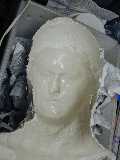












|
Set up your studio. Since I live in San Francisco,
a field trip to Kryolan was required.
Kryolan sells an alginate product called Magicast that I used as the
base of the life cast. Lots of old makeup, space for writing notes,
measuring cups, bald cap and spirit gum. We're going to make a big
happy mess, so we need to be in a space where that's okay. |

|
To cradle the alginate negative, we used an old mail
carrier lined with newspaper. |

|
Two rolls of Durashell plaster bandages cut into eight
strips of eight, ten, and twelve inches, with a few smaller pieces left over
for my nose. |

|
Pre-measured Magicast alginate and water, at 71 degrees
Fahrenheit. I used 2 1/4 cups of water and 2 cups of alginate, which
seemed to be the correct amount for the face and neck. It took us two
attempts to get this mix right. The first mix used 60 degree Fahrenheit
water and around 2 1/2 cups of water, and we got soup, not alginate. |

|
The initial coating of alginate. I'm wearing
a cheap bald cap, spirit-gummed to the sides of my face. I breathe
through my nose for about five minutes while the alginate sets. It
tends to run up my nose... so I just blow out quickly when the air holes
start to close. |

|
The alginate is very soft, like egg whites, and I
could open my mouth now and ruin the alginate cast. |

|
Next layer is the Durashell plaster bandages. Between
the two layers, we spread a little Poli Grip in order to adhere the alginate
to the plaster bandages. We oversoaked the bandages a little, so they
took about twenty minutes to dry. |

|
I lean forward and wrinkle my facial muscles and the cast comes off in one piece. Ahhh... I can breathe normally again... |

|
The negative mould, with a 1/8" coating of Ultracal
plaster in it. I applied this with a thin brush in order to try to
minimize air bubbles in the plaster surface. The fan helps to speed
the drying. I let this layer become tacky before adding another coat. |

|
From another angle. This is actually a negative
mould. The light reflection makes the negative look like a positive. |

|
I fill the mould completely with plaster and cotton
towels. An hour later, and the mould has started to cool. I tear
off the bandages and alginate before it cools completely. Some air
bubbles are present, and the towel is showing through on the left side of
the face, but we can repair these problems with more plaster and a matte
knife. |

|
After removing the blotches of plaster caused by air
bubbles, we have a first positive cast. |
| Original versus the duplicate. It took about five hours to make this life cast today. |